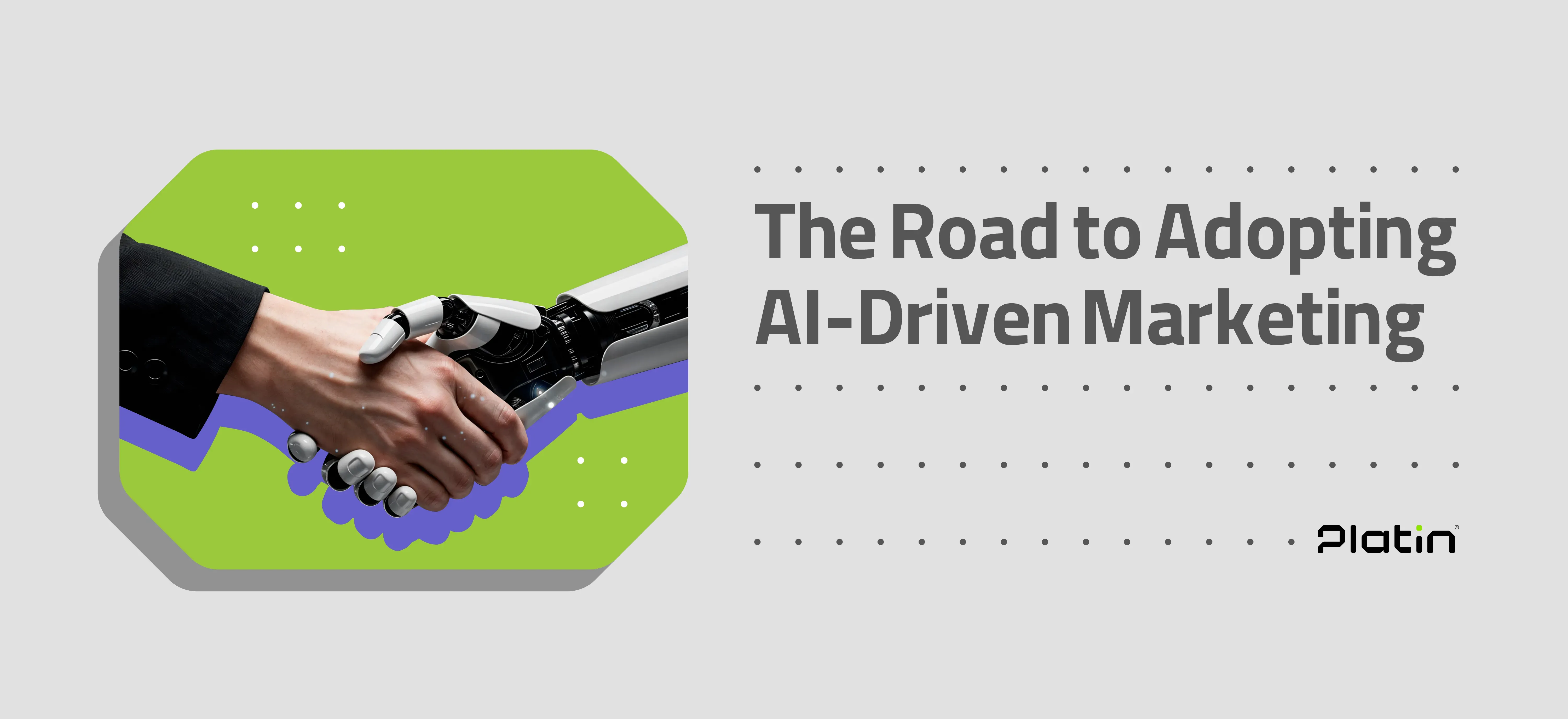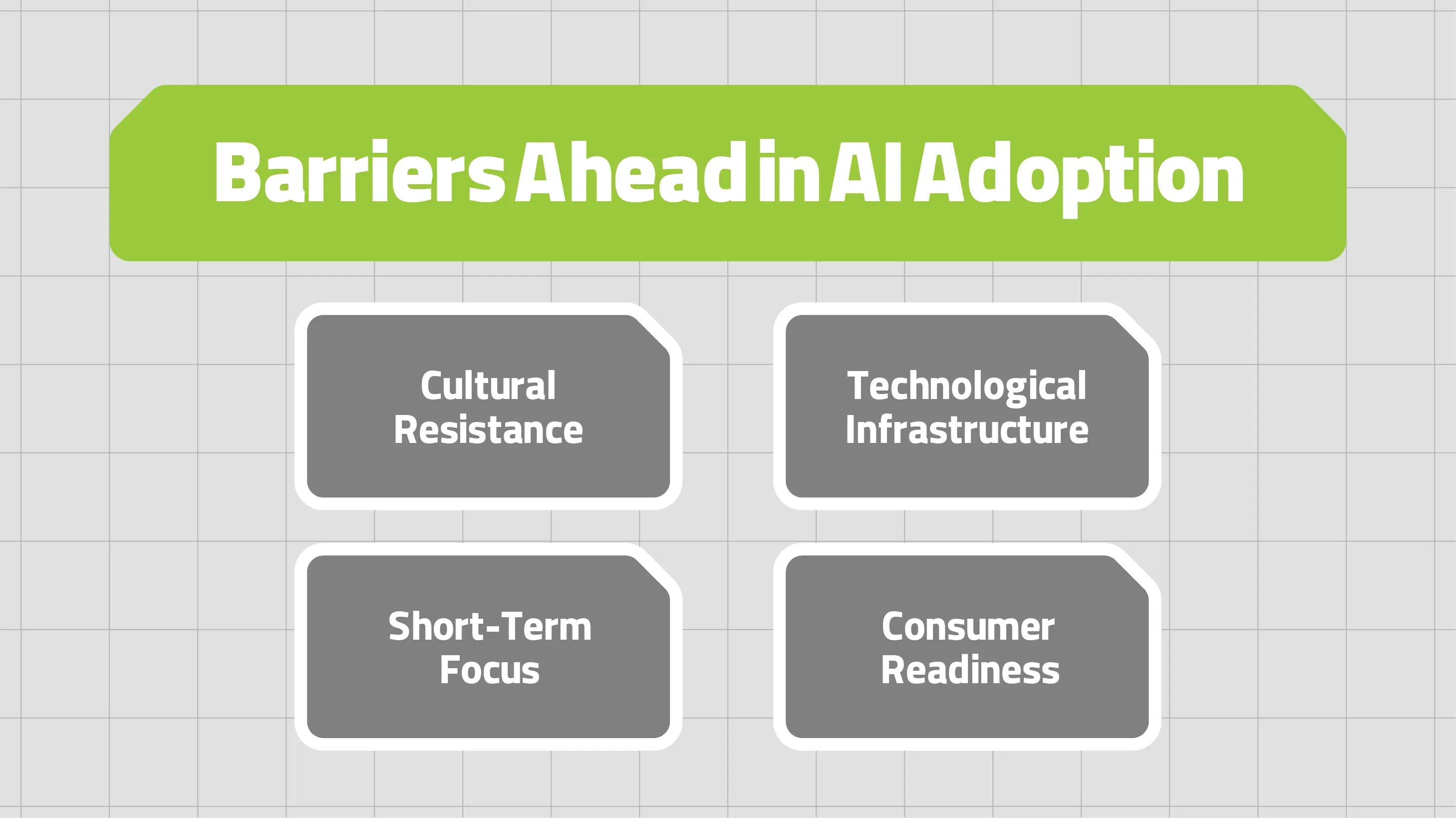The Road to Adopting AI-Driven Marketing

Introduction
Given recent technological advances, the profound impact of artificial intelligence on the marketing industry is undeniable. We have entered an era marked by remarkable innovations in generative models, the emergence of agent-driven solutions, and significant progress in automation and personalization. These developments promise a future, where engaging with audiences will become simpler, more personalized, and more effective. However, the experience of brands, marketing teams, and students alike shows that there is still a considerable gap between these technological prospects and practical realities.
Barriers Ahead in AI Adoption
Although many organizations are motivated and willing to harness the power of AI, they face numerous barriers, which can be categorized into four main groups.

Technological Infrastructure
In many businesses, core software systems and underlying infrastructure remain outdated, and data is scattered across multiple platforms. The lack of integration between platforms makes even deploying a basic AI-powered search tool a major challenge. For example, the digital experience of JD Sports—a leading fast-fashion brand—revealed that before any advanced personalization efforts could succeed, fundamental issues such as website navigation and data retrieval needed to be addressed. Without such foundational improvements, any future AI initiatives would risk failure or poor ROI.
JD Sports, facing challenges with fragmented systems and disjointed digital platforms, collaborated with Algolia to enhance its online shopping experience and deliver smarter, more personalized interactions. This case illustrates that even large brands encounter infrastructural hurdles and must first tackle foundational issues to fully benefit from new technologies.
Cultural Resistance
Technological transformation requires not only technical capabilities but also a cultural shift. Siloed structures, fear of risk, and concerns about AI replacing jobs can hinder collaboration across teams. When managers see no guarantee of quick returns, they tend to be cautious about investing in long-term projects, slowing innovation and reinforcing organizational resistance to change.
The Role of Organizational Culture and the Importance of Internal and External Alignment in Rebranding Success
Multiple studies highlight organizational culture as a key factor in the success or failure of digital transformation projects. For instance, a Capgemini survey found that 62% of respondents cited cultural barriers as the biggest obstacle to digital transformation.

Consumer Readiness
On the other hand, audience reactions vary widely. While some consumers welcome AI-powered services with open arms, others are skeptical of algorithmic decision-making or prefer to maintain human connections. Privacy concerns and transparency around how AI tools function also remain significant barriers. Brands that fail to clearly communicate how their AI solutions work risk losing consumer trust.
According to a KPMG survey, 63% of consumers worry that AI might compromise their privacy, such as exposing personal information or enabling unauthorized access to their data. These concerns are particularly heightened around issues like fake news, fraud, and cybersecurity. However, 70% of consumers still believe that the benefits of AI outweigh its risks.
Short-Term Focus
In unstable economic conditions, many companies prioritize immediate results to offset costs. Short-term goals like cutting expenses and boosting sales often take precedence, pushing long-term projects such as AI infrastructure deployment aside or shelving them altogether. Yet, experience shows that successful digital transformation requires patience, commitment, and incremental investment—not quick fixes.
A McKinsey report highlights that due to financial pressures and economic uncertainty, many companies have paused or scaled back complex, long-term projects like AI deployment—potentially undermining their long-term growth and innovation.
A Pragmatic Path: Closing the Gaps with Gradual Innovation and Empathy
The key takeaway is that gradual, iterative innovation driven by continuous learning is far more sustainable than sudden, disruptive revolutions. For example, while working with a leading fast-fashion brand, the suggested approach was to deploy an AI-powered assistant in three phases instead of diving straight into full-scale personalization:
Enhancing navigation through smart search capabilities;
Personalizing content based on users’ behavioral history;
Increasing engagement by evolving the AI assistant into a personal style advisor.
This phased approach allows organizations to test, measure, and refine AI tools step by step, resolving weaknesses before scaling solutions across the organization.
Another critical lesson is the role of empathy in designing AI-driven solutions. Organizations are rarely short on ambition; instead, real operational constraints often hold them back. Innovation succeeds when it respects internal concerns and aligns with both organizational values and customer needs. For instance, after facing challenges with unsold inventory and financial losses, H&M adopted a phased approach to integrate AI into its operations. Initially, it leveraged machine learning algorithms to better analyze consumer behavior and regional trends, improving demand forecasting. This insight helped optimize inventory across stores based on actual demand. Finally, by combining AI-generated insights with human expertise, H&M was able to refine its sales strategies and reduce waste. This empathetic design model clearly demonstrates how respecting limitations while addressing customer needs can foster sustainable growth.

Key Focus Areas for the Near Future: Iteration, Evolution, and a Human-Centric Approach
Empathy as a Strategic Imperative
A deep understanding of audience emotions, needs, and concerns forms the foundation for meaningful engagement and building trust.
Iteration over Revolution
The myth of overnight transformation must be replaced by a focus on small, measurable, and continuous improvements that minimize risks and maximize learning.
Trust and Transparency
As AI’s influence expands, trust will become a core currency in marketing. Transparency about data sources, algorithms, and decision-making processes will be key to ensuring customer satisfaction and loyalty.
Community-Building and Authentic Connections
The shift from purely transactional marketing to building active communities around brands will be crucial—creating spaces where audiences can contribute, share experiences, and engage in meaningful two-way interactions.
Future Outlook
Companies are expected to address underlying challenges such as optimizing digital infrastructure, improving data integration processes, and crafting clear technological roadmaps to enable sustainable innovation.
Marketing teams, meanwhile, should play an active role in shaping audience perceptions and behaviors while staying committed to the ethical use of emerging technologies, especially AI, and upholding their broader social responsibilities.
The next generation of industry professionals and leaders must balance ambition with realism, pursue incremental innovation, and cultivate a culture of empathy.
Ultimately, true marketing growth does not lie in seductive promises of technology alone but in focusing on people—their needs, emotions, and values. AI technologies will continue to evolve at a rapid pace, but only organizations that move forward with gradual, transparent, and empathetic steps will be able to harness these powerful waves, stay ahead of the competition, and navigate the path ahead with steady commitment, continuous learning, and a focus on what truly matters.
References: